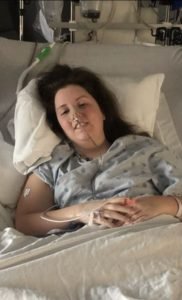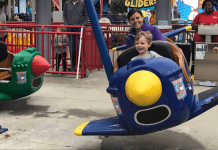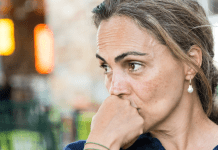This post is sponsored by HCA Midwest Health.
On my last day of post-surgical cardiac rehabilitation in Dec. 2021, I sat outside the hospital in my car and cried. Just seven months earlier, I had swallowed a handful of medication in a desperate attempt to get relief from an illness that doctors had struggled to diagnose since I was a little girl. Fortunately, my husband found me unconscious, and I woke up three days later in the intensive care unit happy to be alive. I spent the next seven days in intensive care and three more on the cardiac floor before returning home to Bald Knob, Arkansas to face an uncertain future.
When I was 9 or 10, I began noticing that there were times when my heart would beat very fast for no apparent reason. Quite often, I felt very tired afterward. When I was 13, I fainted for the first time. Curious about what was going on with my body, I went to the doctor for the first time in 2005 or 2006. After looking me over, his unofficial diagnosis was an eating disorder. I’ve always been slightly built, so the doctor assumed I wasn’t eating or drinking enough. I swore that I wasn’t skipping meals, but he didn’t believe me. Eventually, they thought it was a blood sugar issue causing an imbalance in my system. Finally, the doctor labeled it anxiety and said it was all in my head.
During my third year of college, I was referred to another hospital where I was diagnosed with neurocardiogenic syncope, a fainting episode caused by a sudden drop in blood flow to the brain. The treatment was to drink more water and eat more salt, which I tried, but the fainting continued. I was prescribed medications. But those didn’t work, and the side effects made me feel worse. Eventually, I was diagnosed with postural orthostatic tachycardia syndrome (POTS), a condition when your heart rate increases very quickly after getting up from sitting or lying down. I believe at this point the doctors attempted a left ventricular ablation but were unable to pinpoint an exact spot where my problem was located during the cardiac mapping.
When I was 25 years old, doctors told me a pacemaker with rate drop response would stop my fainting episodes. Hoping at long last they had figured it out, I happily signed on. But two weeks later, the fainting started all over again. Frustrated by the outcome, my doctor started blaming me for what had happened. He said I was not following his directions for hydration and nutrition. I felt like the doctor had given up on me and was no longer listening to what I had to say, so my dad tagged along for my next doctor’s appointment. Together, we demanded to see a specialist. We had heard that a hospital in Nashville, had an excellent autonomic dysfunction clinic and asked to be referred there. The doctor told us we were wasting our time, but begrudgingly gave us a referral.
When we arrived at the hospital in Nashville, they performed all sorts of tests before diagnosing me with Ehlers-Danlos Syndrome, POTS and small fiber neuropathy. We tried multiple drugs, but none of them worked long term. Meanwhile, I was getting sicker and sicker. Two weeks before attempting suicide in April 2021, I desperately messaged my doctor. I begged him to try something new because things were just getting worse. I got no response.
At this point, I had lost all hope. My options were running out. I had been on countless medications and implemented multiple lifestyle changes with no long-term effect. I had resigned from my job as a school counselor because my ability to work had become so unpredictable. Even online teaching was too much because of my frequent fainting. I went on FMLA three times in four years and had been denied twice for disability benefits. I tried not to internalize everything that was going on, but it was my body that was failing. I told myself if I could eliminate the source of the problems, then those around me could move on with their lives.
Finding the Kansas City Heart Rhythm Institute
After my suicide attempt, the cardiologist at our local hospital wanted to put me on another medication, but my husband and I resisted. Instead, he referred us to a heart specialist in Little Rock, Arkansas, and that’s when things finally started to look up. The doctor realized early on that he didn’t have the skills required to help me find relief, but he knew somebody who did – Dr. Dhanunjaya “DJ” Lakkireddy, M.D., medical director at Kansas City Heart Rhythm Institute – a part of HCA Midwest Health – in Overland Park, Kansas. I remember he told us, “I’m sending you to the best place in the country to get help.” I got a call from Kansas City Heart Rhythm Institute and as soon as I hung up, I burst into tears. For the first time in a long, long time they were tears of hope and not sadness.
My husband and I weren’t expecting miracles when we arrived in Kansas City; we just hoped to return some level of normalcy. I simply wanted to be able to at least cook my own meals, take a shower on my own – anything to show some sort of independence. Dr. Lakkireddy listened intently as I described everything that had been going on since my symptoms began when I was a little girl. He calmly explained exactly what was going on with my body and why medications and treatments hadn’t worked. He explained that in addition to POTS, I had inappropriate sinus tachycardia (IST), a condition where the heart beats too fast for no apparent reason. IST mainly affects young women and can cause palpitations, fatigue, lightheadedness and exercise intolerance.
He walked us through the surgery and thoroughly explained the risks and recovery. Looking back, I have to admit that even though we were encouraged when Dr. Lakkireddy said he had patients who were able to go back to work after recovering from the surgery, there was a large part of me that was still very skeptical.
He introduced us to Cardiothoracic Surgeon Ahmed A. Romeya, M.D., and the next day we met with him between surgeries to map out the details of my surgery. He performed my sinus node-sparing hybrid ablation procedure on Monday, Aug. 23, 2021. By Thursday, we were able to make the seven-hour drive home. I was determined to get the most out of my cardiac rehab and gain back as much of my life as possible. Rehab went surprisingly well. By the end of December 2021, I felt healthy enough to land a job in my old school district.
 In less than a year, I’ve gone from hitting rock bottom to being able to drive myself to a full-time job. I still faint, and sometimes I still have to miss work. I have to watch my diet, and I am still on blood pressure medication, but it’s much more manageable now. In the last year, I’ve celebrated getting my life back. I climbed Sugar Loaf Mountain in Heber Springs, Arkansas – while it’s not big by any means, a mountain is a mountain.
In less than a year, I’ve gone from hitting rock bottom to being able to drive myself to a full-time job. I still faint, and sometimes I still have to miss work. I have to watch my diet, and I am still on blood pressure medication, but it’s much more manageable now. In the last year, I’ve celebrated getting my life back. I climbed Sugar Loaf Mountain in Heber Springs, Arkansas – while it’s not big by any means, a mountain is a mountain.
I watched my brother marry the love of his life in Florida. I went shopping by myself. Celebrated my 30th birthday. I spent an entire day baking Christmas cookies with my husband. I climbed the St. Augustine’s lighthouse. And helped build a swimming pool in the 100-degree Arkansas heat. I continue to exercise regularly, and I’ve learned how valuable a functioning body can be.
I’ve lived more in the past year than I had in the previous 10 years combined. When I say I can’t thank you enough, I mean it with every cell in my body. Dr. Lakkireddy and Dr. Romeya changed my life!
Suffering from an undiagnosed condition is overwhelming and frustrating. I want those who are going through something like this to learn from my journey:
-
Give yourself grace.
-
Know it’s not your fault.
-
Keep fighting for treatment options.
-
Take this one day at a time.
-
Keep a journal. The more data you can collect for doctors, the better.
-
Listen to your body.
-
DON’T LOSE HOPE! Researchers are discovering more and more about IST than they ever have before.
Written by Emma Nelson, elementary school teacher in Bald Knob, Arkansas.
Do you have a family member who has been diagnosed with atrial fibrillation (AFib)? Or maybe you have AFib, and your family members don’t realize they could also be at risk for it. We now know there is a hereditary link associated with AFib. But good news! There are actions you can take to prevent the onset of AFib, and actions you can take to better manage the condition. Learn more and find a physician at kcheartrhythm.com.
















